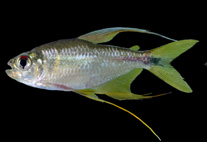Abstract
Analysis of morphometric and meristic data from specimens obtained from various river basins along the distribution of Nematocharax venustus revealed intraspecific variation among geographically isolated populations. A comparative analysis of these data with data from the original description of N. costai, in addition to data obtained from the holotype and topotypes of the species, showed broad overlap and absence of morphological features supporting the recognition of two species within Nematocharax. Characters previously used to distinguish N. costai from N. venustus, such as presence of hooks or spinules on dorsal and pelvic fins, number of hooks on anal-fin rays, occurrence of a pink horizontal mark on the caudal peduncle, number of supraneurals, and coloration of the pelvic-fin filament, are not useful to distinguish the two putative species. Thus, N. costai is considered herein as a junior synonym of N. venustus. Presence of a complete lateral line and length of fin-filaments of N. venustus are briefly discussed and a current overview of the distribution of the species is given. In view of the proposed synonymy of a so recently described species and aiming to avoid problems of similar nature in the future, we also take the opportunity to reinforce herein the importance of the examination of large population samples and of intraspecific variation of secondary sexual features.

